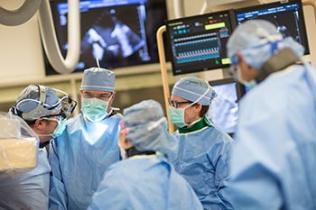Structural Heart Disease is a branch of interventional cardiology offering cutting edge catheter-based and minimally invasive treatment options for diseases and conditions in the non-coronary structures of the heart, such as the interior walls, valves, arteries, and veins.
Our services include:
- Advanced procedures and treatments in our Cardiac Catheterization Laboratory by board-certified interventional cardiologists with specialized training in structural heart disease, working in collaboration with cardiac surgeons.
- An emphasis on effective communication and decision making with you about complex structural heart treatments. Multiple team members participate in decision making with you using a shared decision making approach.
- Leading edge clinical research and trials of new structural heart devices and procedures, including the TAVR PARTNER3 Trial, and a study on shared decision making in the treatment of aortic stenosis.
Much of structural heart disease focuses on those of you with valvular disease who are not ideal candidates for open-heart surgery. We participate in the interdisciplinary Valvular Heart Disease program with cardiac surgeons, cardiac imagers, and other specialists to review and recommend the best treatment approach.
Treatment options
Heart and Vascular Center recognized by U.S. News & World Report for 2025-2026
Dartmouth Hitchcock Medical Center is rated as high-performing in transcatheter aortic valve replacement (TAVR) by U.S. News & World Report in 2025-2026.
TAVR/TAVI (Transcatheter Aortic Valve Replacement/Implantation)
Our center is one of the few in the country currently able to offer TAVR for patients of all risk levels—and the first in northern New England to offer TAVR with low-risk aortic valve stenosis through the PARTNER3 clinical trial.
Referred to as either transcatheter aortic valve replacement (TAVR) or transcatheter aortic valve implantation (TAVI), this minimally invasive procedure repairs the aortic valve without removing the old, damaged valve. Similar to the way a stent is placed in an artery, TAVR delivers a replacement valve to the aortic valve site through a catheter. The new valve is expanded and pushes the old valve leaflets out of the way to take over the job of regulating blood flow.
TAVR PARTNER3 trial for low-risk, severe aortic valve stenosis
Our center has participated in the PARTNER trial since its inception, which is studying the safety and effectiveness of placing a new valve device through a catheter rather than open surgery. We are one of just 50 centers currently offering enrollment in the PARTNER3 trial for those with severe aortic stenosis at low operative risk.
TMVR (Transcatheter Mitral Valve Repair) with MitraClip®
We are one of the few centers in New England offering transcatheter mitral valve repair with MitraClip® to treat mitral valve disorders.
The minimally invasive TMVR procedure uses a catheter to guide the MitraClip device through a vein in the leg to reach the heart when you have a defective or leaky mitral valve and are not a candidate for open surgery. The MitraClip device clips together a small area of the mitral valve, which continues to open and close on either side of the clip. The device allows blood flow on both sides of the clip but reduces the back flow of blood in the wrong direction.
Left Atrial Appendage (LAA) closure with WATCHMAN
The WATCHMAN procedure is an alternative to blood thinners for those of you with AFib (atrial fibrillation or irregular heartbeat) who are at high risk of stroke.
AFib can cause blood to clot in a small pouch of the heart called the left atrial appendage (LAA). Blood clots can break loose from the LAA and travel to the brain, causing a stroke, or to other parts of the body. The WATCHMAN procedure utilizes a catheter to place a small umbrella-like device to block off the LAA and keep harmful blood clots from escaping.
Complex structural heart disease procedures
Additional complex procedures available through the Structural Heart Disease Program include:
- Paravalvular leak closure, to address prosthetic valves that are leaking following surgical or transcatheter placement.
- Percutaneous balloon valvuloplasty of the mitral valve for rheumatic mitral stenosis.
- Options for transcatheter valve replacement in the native mitral valve if you are at very high risk for surgery and have the appropriate anatomy. In addition, transcatheter valve-in-valve procedures are being performed in both the aortic and mitral position.
- Coronary fistulae closure to address abnormal connections from the coronary vessels to other parts of the heart, performed using a collaborative approach between adult and pediatric interventional cardiologists.

